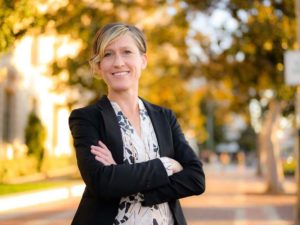
1. Spending by the oil and gas industry on local races casts doubt on whether voters can trust their elected leaders to protect them from the impacts of pollution and climate change. Will you pledge to refuse any donations from the fossil fuel industry?
Yes, I pledge to refuse any donations from the fossil fuel industry and affiliated groups. As a member of the Pasadena City Council, I will make my decisions consistent with the science of climate change and achieving alternative transportation goals outlined in the City’s Climate Action Plan and Mobility Plan.
2. According to the most recent data from the California Office of Traffic Safety, in 2017 Pasadena had the second-highest number of senior pedestrians killed or injured in traffic collisions, and the fourth-highest number of people on bikes killed or injured, among 58 similarly sized cities across California. What can the City do to make our streets safer for everyone, especially older adults and children? Do you support a Vision Zero policy for Pasadena?
Pasadena is known as a place of wonderful historic neighborhoods and beautiful architecture. I want all of us Pasadenans to be as proud of our streets as we are of our historic architecture. Speeding and reckless driving are leading causes of deaths and serious injuries among our most vulnerable populations, namely children and the elderly.
If we are to maintain the Pasadena promise for all, we must ensure our streets are safe for all. Pasadena has a “Safer Streets” program (http://saferstreets.cityofpasadena.net/) that prioritizes safety improvements for streets and intersections where the most crashes and injuries occur. I would work to expand this program for District 2, set measurable goals, and establish timelines for safety improvements.
3. Pasadena streets around schools are frequently unsafe. This discourages parents from allowing their children to walk or bike to school, and makes the health benefits of active transportation inaccessible for many Pasadena youth. If elected, how would you prioritize student safety and mobility around schools?
If elected, I would expand Pasadena’s Safe Routes to School by establishing a way to more quickly implement safety improvements along designated student walking routes. We now have established inexpensive but effective ways to improve safety using paint and plastic bollards to shorten crossing distances at intersections and channelize traffic, for example, which would not only improve safety for people walking or biking, but also improve traffic flow.
4. Pasadena Transit service is currently limited in many Pasadena neighborhoods, with service stopping at 7pm and not even provided to some neighborhoods on Sundays. In addition, many bus stops in Pasadena lack basic amenities like shade and seating. With so many older adults and other residents who cannot drive a vehicle, how can the City improve the comfort and convenience of its local bus service?
Because LA Metro is in the middle of implementing its NextGen Bus Plan, which is a plan to improve bus transit across LA County, Pasadena Transit has a unique opportunity to coordinate with Metro on a new service pattern and receive new grants towards improving service and improve amenities. I will work closely with Pasadena’s transportation department so Pasadena Transit can expand service and complement changes in LA Metro bus service as needed.
5. According to Pasadena’s Climate Action Plan, transportation is the number one source of greenhouse gas (GHG) emissions in the City of Pasadena, responsible for an estimated 52% of emissions. Gas-powered mobility is also the largest source of greenhouse gases in California, with GHGs increasing in recent years as more Californians purchase larger and less fuel-efficient SUVs and trucks (almost 60% of new car sales in California were SUVs in 2018), and drive more miles. Despite the growing popularity of electric vehicles statewide, these developments are now threatening to derail the state’s 2030 climate goals. What can the City do to support greater use of sustainable transportation and reduce transportation-related greenhouse gas emissions?
We are 5 years, or one third, into the timeline stated in the Pasadena Mobility Plan. But the plan is not anywhere close to one third implemented. I will work to speed up the implementation of sustainable transportation components of the Mobility Plan and support related initiatives on City Council.
6. Pasadena lacks a safe network of separated lanes for bicycling, scooting, and other modes of micro-mobility. The few existing routes too often consist of narrow, unprotected striped lanes placed directly adjacent to fast-moving cars or shared use lanes marked with ‘sharrows’ in which people on bikes are put in direct conflict with drivers. The lack of safe space for these users often results in sidewalk riding, where conflicts with pedestrians are more likely to take place. Do you support building out a robust and connected bike/roll network with protected lanes to enable residents of all ages and abilities to get around safely, and if so, how will you work to make this a reality?
A safe, robust, and useful bike network is essential for Pasadena to meet the needs of residents and stated mobility and climate goals. Pasadena has been a city of innovation, and we can be creative now about how to use the public right-of-way for people who want to walk, bike, or roll instead of drive. But the process has some sensitivities that must be addressed before any changes are made. I see it as my job to convene stakeholders, to make sure community voices are heard, and to collaborate with and act as a sounding board for residents when mobility or street safety issues are raised in the community.
